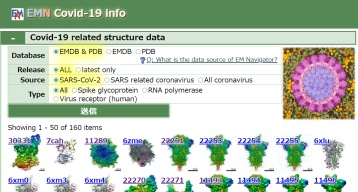+ Open data
Open data
- Basic information
Basic information
| Entry | Database: EMDB / ID: EMD-3605 | |||||||||
|---|---|---|---|---|---|---|---|---|---|---|
| Title | The structure of the full-length ZntB transporter | |||||||||
 Map data Map data | ||||||||||
 Sample Sample |
| |||||||||
 Keywords Keywords | ZntB / zinc transport / CorA / membrane protein | |||||||||
| Function / homology |  Function and homology information Function and homology informationzinc efflux transmembrane transporter activity / zinc ion import across plasma membrane / solute:proton symporter activity / cobalt ion transmembrane transporter activity / zinc ion transmembrane transporter activity / zinc ion transmembrane transport / magnesium ion transmembrane transporter activity / cobalt ion binding / magnesium ion binding / plasma membrane Similarity search - Function | |||||||||
| Biological species |   | |||||||||
| Method | single particle reconstruction / cryo EM / Resolution: 4.2 Å | |||||||||
 Authors Authors | Cornelius G / Stetsenko A / Scheres SHW / Slotboom DJ / Guskov A | |||||||||
| Funding support |  Netherlands, 1 items Netherlands, 1 items
| |||||||||
 Citation Citation |  Journal: Nat Commun / Year: 2017 Journal: Nat Commun / Year: 2017Title: The structural basis of proton driven zinc transport by ZntB. Authors: Cornelius Gati / Artem Stetsenko / Dirk J Slotboom / Sjors H W Scheres / Albert Guskov /   Abstract: Zinc is an essential microelement to sustain all forms of life. However, excess of zinc is toxic, therefore dedicated import, export and storage proteins for tight regulation of the zinc ...Zinc is an essential microelement to sustain all forms of life. However, excess of zinc is toxic, therefore dedicated import, export and storage proteins for tight regulation of the zinc concentration have evolved. In Enterobacteriaceae, several membrane transporters are involved in zinc homeostasis and linked to virulence. ZntB has been proposed to play a role in the export of zinc, but the transport mechanism of ZntB is poorly understood and based only on experimental characterization of its distant homologue CorA magnesium channel. Here, we report the cryo-electron microscopy structure of full-length ZntB from Escherichia coli together with the results of isothermal titration calorimetry, and radio-ligand uptake and fluorescent transport assays on ZntB reconstituted into liposomes. Our results show that ZntB mediates Zn uptake, stimulated by a pH gradient across the membrane, using a transport mechanism that does not resemble the one proposed for homologous CorA channels. | |||||||||
| History |
|
- Structure visualization
Structure visualization
| Movie |
 Movie viewer Movie viewer |
|---|---|
| Structure viewer | EM map:  SurfView SurfView Molmil Molmil Jmol/JSmol Jmol/JSmol |
| Supplemental images |
- Downloads & links
Downloads & links
-EMDB archive
| Map data |  emd_3605.map.gz emd_3605.map.gz | 2.5 MB |  EMDB map data format EMDB map data format | |
|---|---|---|---|---|
| Header (meta data) |  emd-3605-v30.xml emd-3605-v30.xml emd-3605.xml emd-3605.xml | 13.3 KB 13.3 KB | Display Display |  EMDB header EMDB header |
| Images |  emd_3605.png emd_3605.png | 128.5 KB | ||
| Filedesc metadata |  emd-3605.cif.gz emd-3605.cif.gz | 5.7 KB | ||
| Archive directory |  http://ftp.pdbj.org/pub/emdb/structures/EMD-3605 http://ftp.pdbj.org/pub/emdb/structures/EMD-3605 ftp://ftp.pdbj.org/pub/emdb/structures/EMD-3605 ftp://ftp.pdbj.org/pub/emdb/structures/EMD-3605 | HTTPS FTP |
-Validation report
| Summary document |  emd_3605_validation.pdf.gz emd_3605_validation.pdf.gz | 380.7 KB | Display |  EMDB validaton report EMDB validaton report |
|---|---|---|---|---|
| Full document |  emd_3605_full_validation.pdf.gz emd_3605_full_validation.pdf.gz | 380.2 KB | Display | |
| Data in XML |  emd_3605_validation.xml.gz emd_3605_validation.xml.gz | 5.6 KB | Display | |
| Data in CIF |  emd_3605_validation.cif.gz emd_3605_validation.cif.gz | 6.5 KB | Display | |
| Arichive directory |  https://ftp.pdbj.org/pub/emdb/validation_reports/EMD-3605 https://ftp.pdbj.org/pub/emdb/validation_reports/EMD-3605 ftp://ftp.pdbj.org/pub/emdb/validation_reports/EMD-3605 ftp://ftp.pdbj.org/pub/emdb/validation_reports/EMD-3605 | HTTPS FTP |
-Related structure data
| Related structure data | 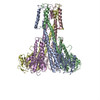 5n9yMC M: atomic model generated by this map C: citing same article ( |
|---|---|
| Similar structure data |
- Links
Links
| EMDB pages |  EMDB (EBI/PDBe) / EMDB (EBI/PDBe) /  EMDataResource EMDataResource |
|---|
- Map
Map
| File |  Download / File: emd_3605.map.gz / Format: CCP4 / Size: 22.2 MB / Type: IMAGE STORED AS FLOATING POINT NUMBER (4 BYTES) Download / File: emd_3605.map.gz / Format: CCP4 / Size: 22.2 MB / Type: IMAGE STORED AS FLOATING POINT NUMBER (4 BYTES) | ||||||||||||||||||||||||||||||||||||||||||||||||||||||||||||
|---|---|---|---|---|---|---|---|---|---|---|---|---|---|---|---|---|---|---|---|---|---|---|---|---|---|---|---|---|---|---|---|---|---|---|---|---|---|---|---|---|---|---|---|---|---|---|---|---|---|---|---|---|---|---|---|---|---|---|---|---|---|
| Projections & slices | Image control
Images are generated by Spider. | ||||||||||||||||||||||||||||||||||||||||||||||||||||||||||||
| Voxel size | X=Y=Z: 1.43 Å | ||||||||||||||||||||||||||||||||||||||||||||||||||||||||||||
| Density |
| ||||||||||||||||||||||||||||||||||||||||||||||||||||||||||||
| Symmetry | Space group: 1 | ||||||||||||||||||||||||||||||||||||||||||||||||||||||||||||
| Details | EMDB XML:
CCP4 map header:
| ||||||||||||||||||||||||||||||||||||||||||||||||||||||||||||
-Supplemental data
- Sample components
Sample components
-Entire : Pentameric zntb transporter
| Entire | Name: Pentameric zntb transporter |
|---|---|
| Components |
|
-Supramolecule #1: Pentameric zntb transporter
| Supramolecule | Name: Pentameric zntb transporter / type: complex / ID: 1 / Parent: 0 / Macromolecule list: all |
|---|---|
| Source (natural) | Organism:  |
-Macromolecule #1: Zinc transport protein ZntB
| Macromolecule | Name: Zinc transport protein ZntB / type: protein_or_peptide / ID: 1 / Number of copies: 5 / Enantiomer: LEVO |
|---|---|
| Source (natural) | Organism:  |
| Molecular weight | Theoretical: 36.652082 KDa |
| Recombinant expression | Organism:  |
| Sequence | String: MEAIKGSDVN VPDAVFAWML DGRGGVKPLE NTDVIDEAHP CWLHLNYVHH DSAQWLATTP LLPNNVRDAL AGESTRPRVS RLGEGTLIT LRCINGSTDE RPDQLVAMRV YMDGRLIVST RQRKVLALDD VVSDLEEGTG PTDCGGWLVD VCDALTDHSS E FIEQLHDK ...String: MEAIKGSDVN VPDAVFAWML DGRGGVKPLE NTDVIDEAHP CWLHLNYVHH DSAQWLATTP LLPNNVRDAL AGESTRPRVS RLGEGTLIT LRCINGSTDE RPDQLVAMRV YMDGRLIVST RQRKVLALDD VVSDLEEGTG PTDCGGWLVD VCDALTDHSS E FIEQLHDK IIDLEDNLLD QQIPPRGFLA LLRKQLIVMR RYMAPQRDVY ARLASERLPW MSDDQRRRMQ DIADRLGRGL DE IDACIAR TGVMADEIAQ VMQENLARRT YTMSLMAMVF LPSTFLTGLF GVNLGGIPGG GWQFGFSIFC ILLVVLIGGV ALW LHRSKW L UniProtKB: Zinc transport protein ZntB |
-Experimental details
-Structure determination
| Method | cryo EM |
|---|---|
 Processing Processing | single particle reconstruction |
| Aggregation state | particle |
- Sample preparation
Sample preparation
| Buffer | pH: 8 |
|---|---|
| Grid | Model: Quantifoil / Material: GOLD / Mesh: 300 |
| Vitrification | Cryogen name: ETHANE / Chamber temperature: 100 K |
- Electron microscopy
Electron microscopy
| Microscope | FEI TITAN KRIOS |
|---|---|
| Image recording | Film or detector model: GATAN K2 BASE (4k x 4k) / Average electron dose: 2.0 e/Å2 |
| Electron beam | Acceleration voltage: 300 kV / Electron source:  FIELD EMISSION GUN FIELD EMISSION GUN |
| Electron optics | Illumination mode: FLOOD BEAM / Imaging mode: BRIGHT FIELD |
| Experimental equipment | 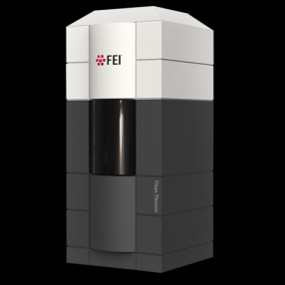 Model: Titan Krios / Image courtesy: FEI Company |
+ Image processing
Image processing
-Atomic model buiding 1
| Refinement | Space: REAL / Protocol: FLEXIBLE FIT |
|---|---|
| Output model |  PDB-5n9y: |
 Movie
Movie Controller
Controller



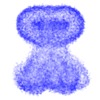
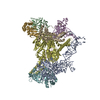
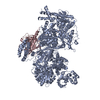

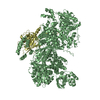
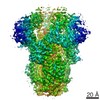

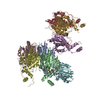
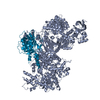
 Z (Sec.)
Z (Sec.) Y (Row.)
Y (Row.) X (Col.)
X (Col.)





















